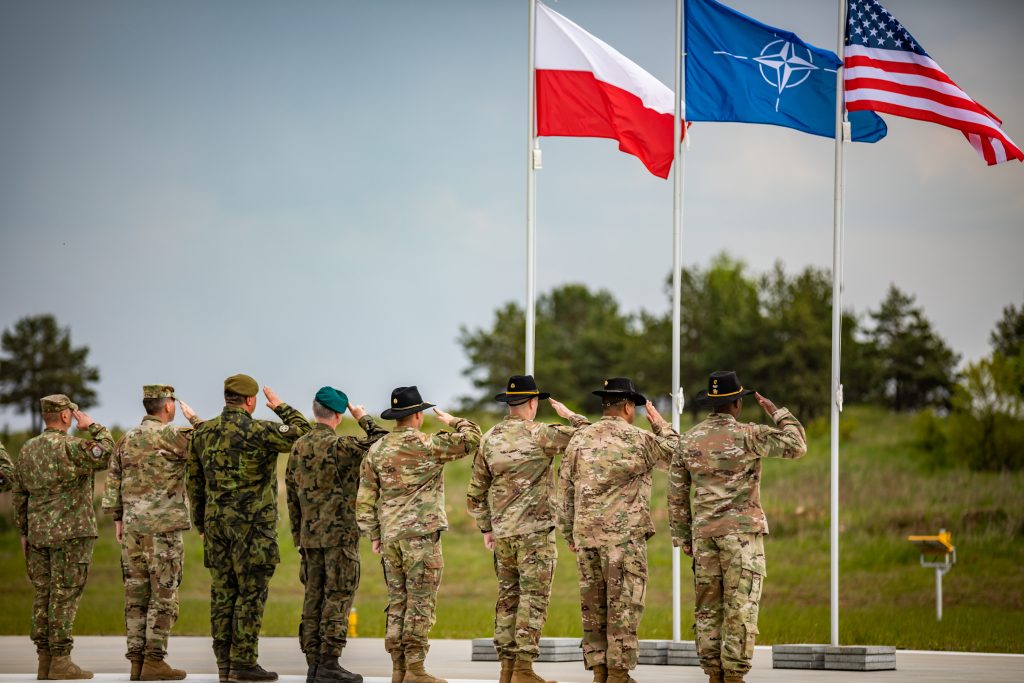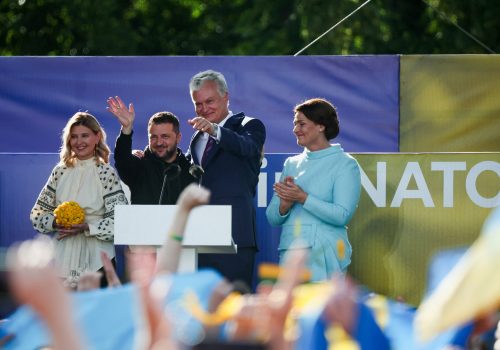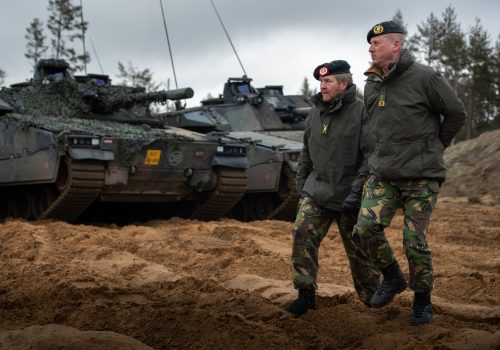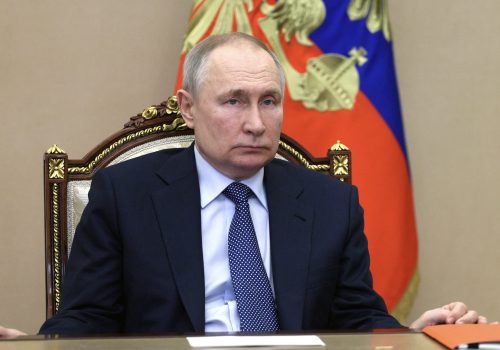Russia’s full-scale invasion of Ukraine in February 2022 upended European security and, as a result, how European countries approach their security. Finland and Sweden shed their historic nonalignment to join NATO. Germany has pursued a “Zeitenwende,” or historic turning point, beginning the overdue task of breaking with decades of overeager outreach to Russia. Not to be outdone, France has embarked on its own tournant historique. But while the United States has provided Ukraine with weapons and stationed more troops in Europe, it has not yet undergone a corresponding change in its strategic approach that the historic moment demands.
What should US strategy in Europe look like going forward? To begin with, the United States needs a Europe strategy that secures American interests while significantly reducing US costs to defend Europe. To get there will require transferring the bulk of conventional deterrence in NATO and, if need be, collective defense onto the European allies, with the United States providing the nuclear umbrella and high-end enablers. The United States must shift the conversation away from the perennial discussion of what percentage of gross domestic product should be spent on defense by each NATO member. Instead, the focus should be on the specific military capabilities each ally needs to provide. The US strategy should be built around cooperation with countries that share common threat perceptions when it comes to Russia, and are thus are determined to work with the United States to ensure their security. In a nutshell, the United States needs a strategy for Europe that focuses its attention and resources on the countries doing the most to counter Russia.
If the United States intends to strengthen NATO while freeing more of its resources for the Indo-Pacific, the time for a turning point is now.
There is truth in the claim that Europe has shirked its defense burden over the past three decades, especially when considering not only reductions in personnel and equipment, but also underinvestment in its defense industry. Critics who charge that Europe has not done enough are correct. For a new Europe strategy to work going forward, Washington needs to become clearheaded about how different countries in NATO perceive the threat Russia poses, as well as which countries are willing contributors to defense and which are reluctant or downright free riders.
European allies who fail to invest in defense should be called out; the problem cannot be papered over with diplomatic niceties. This message should continue to drive internal discussions in the Alliance, and the United States should prioritize and support those allies who are serious about “burden-transferring” when it comes to collective deterrence and defense. The NATO Summit in Vilnius last month committed the Alliance to a new generation of regional plans and a new force model presented by the Supreme Allied Commander Europe, but much will depend on allies’ willingness to rearm and acquire the requisite military capabilities required to implement the plans.
Countries along NATO’s eastern flank have led this effort, paying their “fair share” and more. This includes first and foremost Poland and the Baltic states, but also Finland, Romania, and soon-to-be-ally Sweden. Norway has also stepped up on defense, with the Norwegian Defense Commission recommending significant defense increases. While the Western European allies have been slower off the mark to rebuild their capabilities, there is a new sense of purpose across NATO, with a general consensus that the Alliance has to go back to its collective deterrence and defense roots. This larger consensus should provide the NATO framework within which the United States should execute its new strategy. It is not about treating security commitments to allies differently, for the Washington Treaty provisions apply across the transatlantic space. Rather, it is about leveraging the efforts of the allies that feel the Russian threat most keenly to strengthen NATO and lower costs for the United States.
With Finland and Sweden in NATO and Poland committed to building a 300,000-strong army with the largest armor capabilities in Europe, the United States will have allies that are both able and willing to ensure deterrence against Russia holds. The goal should be to bring Ukraine into NATO, thereby adding a future peacetime Ukrainian force of perhaps as many as 350,000 soldiers to the mix. Such a move would dramatically shift the power equation between Russia and NATO in favor of the Alliance, allowing the United States to focus on China without compromising its security interests in Europe.
This new US Europe strategy should prioritize the “intermarium” states between the Nordic, Baltic, and Black seas that are fast becoming the new center of gravity in NATO. They share threat assessments and the determination to invest in their militaries, as well as a willingness to reach for creative solutions to increase their effectiveness. This includes, for instance, the March 16 deal signed by four Nordic countries to operate their air forces jointly. As part of its new strategy, the United States should redeploy some of its forces from Germany to the eastern flank, into Finland, Poland, and possibly Romania, while also asking these countries to deploy their forces in the Baltic states. The United States could then make the case within NATO that Poland should replace Germany in Lithuania as the lead Alliance member implementing the 2014 Framework Nations Concept, and for Finland to replace Canada in Latvia. In short, the United States’ new Europe strategy should place a premium on countries that take their NATO defense commitments to heart and are willing and ready to act in a crisis.
Critics may argue that such a strategy would dilute NATO’s power by not leveraging the traditional US focus on Germany; after all, Washington pushed to include the Federal Republic in NATO in 1955 precisely because without the Bundeswehr the Alliance lacked the manpower and conventional capabilities to deter the Soviet bloc. But this actually reinforces the case for a new US strategy for two reasons: First, NATO’s eastern flank runs today along the borders of Finland, the Baltic states, Poland, and Romania. These are the frontier states of today’s Europe, much as the Bonn Republic was during the Cold War—with Germany today more of a logistical and training hub for US and NATO operations. Second, the threat that Russia poses to Europe is felt most acutely along the eastern flank. To put it differently, just as in the 1950s the geostrategic logic required that the United States prioritize West Germany, today the same imperative should drive Washington to prioritize Poland, Finland, the Nordics, the Baltics, and Romania. In fact, one could argue that it is this geopolitical calculus, in addition to Berlin prioritizing social spending, that has driven Germany to neglect the Bundeswehr, transforming it into a pale shadow of the military West Germany fielded during the Cold War.
This is an opportunity to rethink the United States’ Europe strategy in a way that reflects the US interest of remaining anchored in Europe and matches that interest with a policy that looks to the future. If the United States intends to strengthen NATO while freeing more of its resources for the Indo-Pacific, the time for a turning point is now.
Andrew A. Michta is dean of the College of International and Security Studies at the George C. Marshall European Center for Security Studies in Garmisch, Germany and a nonresident senior fellow at the Scowcroft Strategy Initiative in the Atlantic Council’s Scowcroft Center for Strategy and Security.
The opinions expressed here are those of the author and do not reflect the official policy or position of the George C. Marshall European Center for Security Studies, the US Department of Defense, or the US government.
Further reading
Tue, Jul 11, 2023
The NATO Summit’s underwhelming support for Ukraine
Fast Thinking By
Ukrainian President Volodymyr Zelenskyy didn't get his biggest wish: a timeline for Ukrainian membership in NATO. Our experts are here to decode the communiqué and its ramifications.
Mon, Mar 20, 2023
What NATO can do now to apply lessons from Russia’s war in Ukraine
New Atlanticist By John R. Deni
NATO should be setting higher defense targets for major European allies, exploring hybrid warfare, and more.
Thu, May 4, 2023
Putin’s ‘Eurasian’ fixation reveals ambitions beyond Ukraine
New Atlanticist By Andrew A. Michta
To explain the reasons for the fall of the Soviet Union and chart a course for his country's redemption, the Russian president espouses an ideology offering a fundamental break with the past.
Image: Commanders and soldiers assigned to NATO eFP Battle Group Poland and U.S. Soldiers assigned to the 2nd Cavalry Regiment salute the colors during the exercise Griffin Shock 23 handover takeover ceremony, signifying the Regiment’s transition under the command of the NATO Multinational Division Northeast and the NATO Battle Group Poland to a brigade sized unit in Bemowo Piskie, Poland, May 13, 2023.



